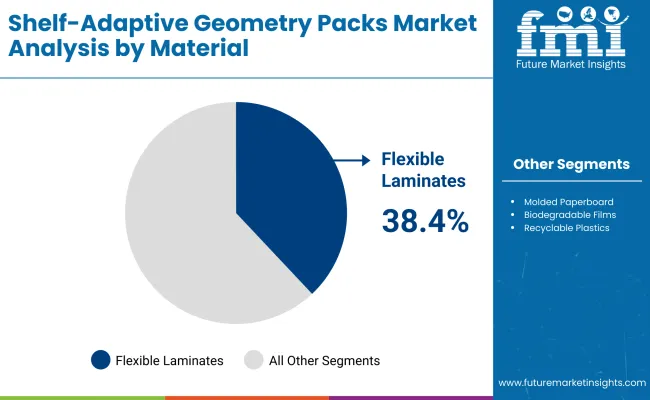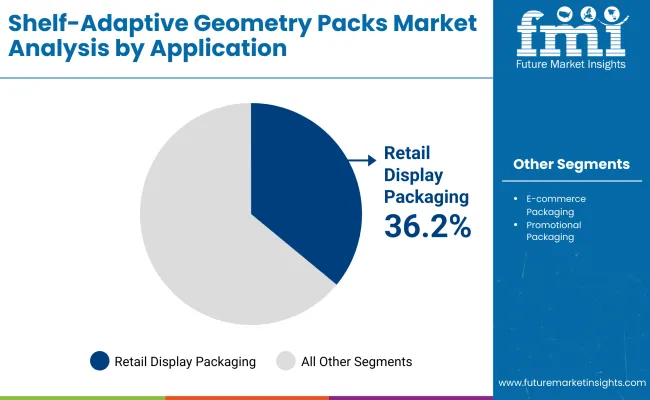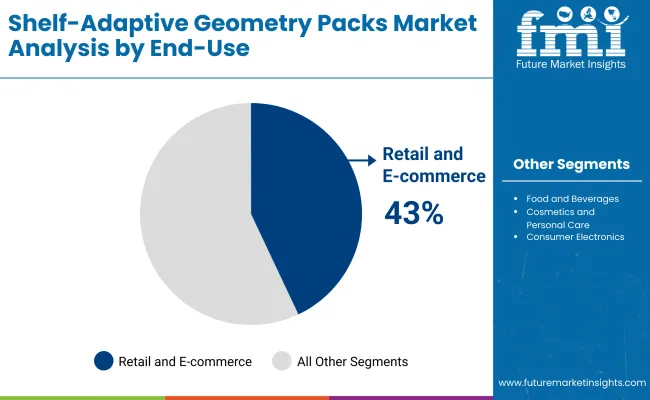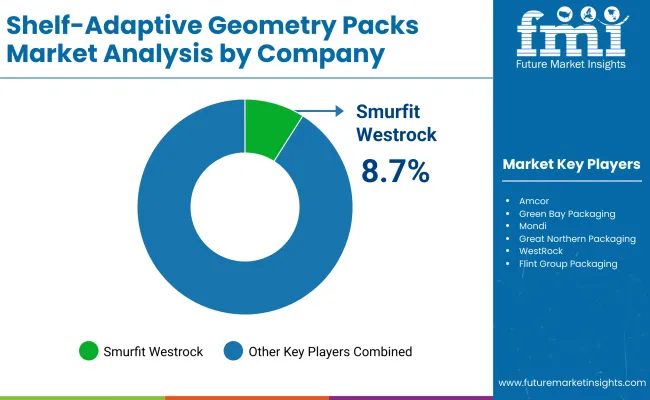The shelf-adaptive geometry packs market will expand from USD 1.6 billion in 2025 to USD 3.0 billion by 2035, growing at a CAGR of 6.5%. The shelf adaptive geometry packs market is being shaped by strong activity across Asia Pacific, North America, and Europe as countries expand retail automation and e-commerce logistics. Growth from 2025 to 2035 is supported by wider use of collapsible, expandable, and flexible modular formats that adapt to changing shelf layouts and improve transport density. Asia Pacific is positioned to lead adoption due to high-volume retail operations in China, rapid e-commerce growth in India, and design-driven packaging innovation in South Korea, which drives regional CAGR of 7.4%. Japan remains an important market for premium, shape-adaptive formats used in cosmetics and high-end consumer goods.
Between 2025 and 2030, recyclable laminates and advanced film structures are expected to gain traction across China, India, and Southeast Asia as packaging lines modernize. North America is driven by the United States, where adaptive display packaging is gaining acceptance in personal care, household goods, and multi channel retail systems. Europe maintains a strong focus on recyclable pack geometries, with Germany, the United Kingdom, and France encouraging eco-efficient packaging layouts for retail display and automated shelf replenishment.

| Metric | Value |
|---|---|
| Industry Size (2025E) | USD 1.6 billion |
| Industry Value (2035F) | USD 3.0 billion |
| CAGR (2025 to 2035) | 6.5% |
Between 2020 and 2024, demand for adaptive packaging solutions surged in online and offline retail. The introduction of collapsible and shape-memory packs optimized logistics and reduced waste. By 2035, the market will reach USD 3.0 billion, driven by flexible materials and customizable pack designs. Asia-Pacific will dominate production due to its rapid e-commerce expansion, while North America and Europe strengthen regulations favoring recyclable, shelf-efficient packaging.
The market’s growth is propelled by increasing retail competition, sustainability goals, and a shift toward ergonomic, lightweight packaging. Brands seek designs that improve shelf presentation, reduce storage costs, and enable consumer reusability, strengthening adoption globally.
The market is segmented by design type, material, application, end-use industry, and region. Design types include expandable, collapsible, shape-memory, and flexible modular packs. Materials comprise flexible laminates, molded paperboard, biodegradable films, and recyclable plastics. Applications include retail display, e-commerce, and promotional packaging. End-use industries span retail and e-commerce, food and beverages, cosmetics and personal care, and consumer electronics.

Expandable packs are projected to capture 37.1% of the market in 2025, supported by their adaptability, reusability, and efficient space utilization. These packs expand or contract based on product volume, optimizing both transport and retail display performance.
Their structural versatility enhances shelf appeal while reducing packaging material waste. Designed for refillable and multi-use cycles, they align with sustainability-focused retail operations. As consumer brands embrace modular and adjustable formats, expandable packs remain the leading design innovation for dynamic packaging solutions.

Flexible laminates are expected to hold 38.4% of the market in 2025, driven by their superior mechanical strength, printability, and lightweight performance. They combine multiple layers typically paper, polymer, and barrier films, to provide protection and durability without compromising recyclability.
Their versatility supports a wide range of product types, from consumer goods to retail displays. Laminates also facilitate downgauging, reducing raw material usage. As manufacturers focus on balancing cost-efficiency with environmental responsibility, flexible laminates continue to lead material adoption.

Retail display packaging is forecast to command 36.2% of the market in 2025, reflecting retailers’ preference for modular, easily adjustable pack designs. Expandable structures improve shelf organization and visual merchandising efficiency while minimizing space waste.
These formats integrate branding and utility, providing protection during transit and an attractive presentation at point-of-sale. Automation in folding and assembly enhances operational speed. As retail environments prioritize flexible layouts and reduced waste, display packaging continues to drive innovation in expandable formats.

Retail and e-commerce are projected to account for 43.0% of the market in 2025, fueled by growing adoption of reusable and flexible packaging solutions. Automation across packaging lines enables consistent sizing and rapid customization for diverse product categories.
Consumers increasingly favor lightweight, collapsible packaging for convenience and sustainability. Brands leverage these designs to enhance fulfillment efficiency and visual appeal. As the convergence of digital retail and eco-conscious packaging accelerates, retail and e-commerce remain the core growth drivers of this market.
The foldable packaging market is being driven by the rapid growth of e-commerce and the increasing shift toward sustainable, space-saving packaging solutions. Brands are adopting foldable designs to reduce logistics costs, optimize storage, and enhance sustainability performance. The demand for lightweight, compact packaging that maintains structural integrity during shipping is fuelling widespread adoption across retail, electronics, and consumer goods sectors.
Market growth is restrained by higher material costs associated with biodegradable, laminated, and multi-layer films. These advanced materials, though eco-friendly, require specialized processing that raises manufacturing expenses. Additionally, durability challenges in repeated folding and unfolding cycles can limit product lifespan. Small and mid-sized businesses often face barriers due to higher procurement and equipment costs linked with foldable packaging formats.
Significant opportunities exist in the development of smart geometry packs utilizing recyclable polymers and adaptive folding mechanisms. Advancements in material science are enabling foldable designs that combine flexibility with strength for a variety of end-use industries. The rise of customizable folding templates for retail and direct-to-consumer packaging allows brands to create distinct, visually engaging solutions while maintaining environmental efficiency.
Customizable 3D pack designs and the integration of digital printing technologies are reshaping the foldable packaging landscape. Modular retail packaging systems that enable quick assembly and disassembly are gaining traction in urban logistics and pop-up retail formats. The convergence of automation, digital design, and sustainability is driving next-generation foldable packaging balancing efficiency, aesthetics, and circular economy principles.

The global shelf-adaptive geometry packs market is expanding as packaging innovation, retail automation, and sustainability converge across industries. Asia-Pacific dominates with advanced manufacturing infrastructure and large-scale e-commerce logistics, while North America leads in smart flexible laminate innovation for adaptive packaging formats. Europe focuses on eco-design, recyclability, and reusability mandates aligned with circular economy targets. The adoption of modular, collapsible, and shape-memory packaging continues to enhance efficiency, shelf appeal, and sustainability across retail and consumer goods sectors.

The USA will grow at 6.6% CAGR, driven by rising investment in smart retail display packaging and reusable e-commerce systems. Modular and shape-adaptive designs are gaining prominence in personal care, cosmetics, and premium consumer goods, reflecting sustainability-focused innovation trends.
Germany will expand at 6.4% CAGR, supported by advancements in laminated film technology and eco-friendly folding carton development. Collaboration between packaging manufacturers and major retailers is fostering innovation in sustainable, shelf-efficient designs.
The UK will grow at 6.5% CAGR, emphasizing shape-memory and biodegradable packaging systems. Sustainability-driven retail initiatives and growing adoption of smart adaptive materials are transforming display packaging across retail and foodservice sectors.
China will grow at 6.5% CAGR, driven by expanding e-commerce packaging demand and large-scale modular packaging production. Local innovation in recyclable folding materials and adaptive factory automation enhances the competitiveness of domestic suppliers.
India will grow at 6.4% CAGR, supported by improving retail infrastructure and supply chain modernization. Lightweight, collapsible, and biodegradable packaging adoption is rising, propelled by sustainability initiatives and efficient space utilization needs.
Japan will grow at 7.3% CAGR, pioneering advancements in flexible and modular packaging for high-end retail. Precision engineering and automation are enhancing the efficiency and adaptability of packaging systems for luxury and gift markets.
South Korea will lead with 7.4% CAGR, focusing on smart, shape-adaptive packaging and sustainability integration. The country’s dominance in high-end retail and cosmetics packaging drives innovation in reusable and recyclable flexible packaging materials.

Japan’s shelf-adaptive geometry packs market, valued at USD 200 million in 2025, is led by expandable packs, which hold 36.0% share due to their efficient shelf utilization and cost-effective logistics. Collapsible packs follow for space-saving benefits, while shape-memory and flexible modular packs are gaining use in temperature-sensitive and refillable product applications.

South Korea’s shelf-adaptive geometry packs market, worth USD 100 million in 2025, is dominated by flexible laminates, capturing 38.7% share for their durability and print flexibility. Molded paperboard supports sustainable retail packaging, while biodegradable films and recyclable plastics enhance lightweight, eco-compliant shelf-ready solutions.

The market is moderately consolidated, with key players including Smurfit Kappa, Amcor, GBP Group, Mondi, Great Northern, WestRock, Flint Group, DS Smith, Packhelp, and Smurfit Kappa. Companies are investing in geometry-responsive packaging, retail-ready designs, and sustainable laminate structures to enhance product value and visibility.
| Item | Value |
|---|---|
| Quantitative Units | USD 1.6 Billion (2025) |
| By Design Type | Expandable, Collapsible, Shape-Memory, Flexible Modular Packs |
| By Material | Flexible Laminates, Molded Paperboard, Biodegradable Films, Recyclable Plastics |
| By Application | Retail Display, E-Commerce, Promotional Packaging |
| By End-Use Industry | Retail & E-Commerce, Food & Beverages, Cosmetics, Consumer Electronics |
| Key Companies Profiled | Smurfit Kappa, Amcor, Mondi, WestRock, DS Smith |
| Additional Attributes | Market driven by sustainability, shelf-optimization, and modular packaging innovation |
The market is valued at USD 1.6 billion in 2025, driven by rising adoption in e-commerce and retail packaging.
It will reach USD 3.0 billion by 2035, supported by innovation in modular and collapsible pack designs.
The market is expected to grow at a CAGR of 6.5% during the forecast period.
Expandable Packs lead with a 37.1% share, favored for flexibility and efficient use of retail shelf space.
Retail and E-Commerce dominate with 43.0% share, reflecting demand for sustainable and adaptive packaging.






Our Research Products

The "Full Research Suite" delivers actionable market intel, deep dives on markets or technologies, so clients act faster, cut risk, and unlock growth.

The Leaderboard benchmarks and ranks top vendors, classifying them as Established Leaders, Leading Challengers, or Disruptors & Challengers.

Locates where complements amplify value and substitutes erode it, forecasting net impact by horizon

We deliver granular, decision-grade intel: market sizing, 5-year forecasts, pricing, adoption, usage, revenue, and operational KPIs—plus competitor tracking, regulation, and value chains—across 60 countries broadly.

Spot the shifts before they hit your P&L. We track inflection points, adoption curves, pricing moves, and ecosystem plays to show where demand is heading, why it is changing, and what to do next across high-growth markets and disruptive tech

Real-time reads of user behavior. We track shifting priorities, perceptions of today’s and next-gen services, and provider experience, then pace how fast tech moves from trial to adoption, blending buyer, consumer, and channel inputs with social signals (#WhySwitch, #UX).

Partner with our analyst team to build a custom report designed around your business priorities. From analysing market trends to assessing competitors or crafting bespoke datasets, we tailor insights to your needs.
Supplier Intelligence
Discovery & Profiling
Capacity & Footprint
Performance & Risk
Compliance & Governance
Commercial Readiness
Who Supplies Whom
Scorecards & Shortlists
Playbooks & Docs
Category Intelligence
Definition & Scope
Demand & Use Cases
Cost Drivers
Market Structure
Supply Chain Map
Trade & Policy
Operating Norms
Deliverables
Buyer Intelligence
Account Basics
Spend & Scope
Procurement Model
Vendor Requirements
Terms & Policies
Entry Strategy
Pain Points & Triggers
Outputs
Pricing Analysis
Benchmarks
Trends
Should-Cost
Indexation
Landed Cost
Commercial Terms
Deliverables
Brand Analysis
Positioning & Value Prop
Share & Presence
Customer Evidence
Go-to-Market
Digital & Reputation
Compliance & Trust
KPIs & Gaps
Outputs
Full Research Suite comprises of:
Market outlook & trends analysis
Interviews & case studies
Strategic recommendations
Vendor profiles & capabilities analysis
5-year forecasts
8 regions and 60+ country-level data splits
Market segment data splits
12 months of continuous data updates
DELIVERED AS:
PDF EXCEL ONLINE
Hand Geometry Biometrics Market Insights - Trends & Growth 2025 to 2035
Track Geometry Measurement System Market Size and Share Forecast Outlook 2025 to 2035
Gel Packs Market Size and Share Forecast Outlook 2025 to 2035
Cold Packs Market Analysis - Size, Share, & Forecast Outlook 2025 to 2035
Perfume Packs Market Size and Share Forecast Outlook 2025 to 2035
Analyzing Perfume Packs Market Share & Industry Leaders
Portion Packs Market Insights – Growth & Demand 2024-2034
Daily Backpacks Market Size and Share Forecast Outlook 2025 to 2035
Hiking Backpacks Market Analysis - Trends, Growth & Forecast 2025 to 2035
PVC Blister Packs Market
Stretch Film Packs Market Insights on Type, Product, Application, Industry, and Region - 2025 to 2035
Portion Control Packs Market
Bio-Fiber Tether Packs Market Analysis - Size and Share Forecast Outlook 2025 to 2035
Molded Fiber Wine Packs Market Size and Share Forecast Outlook 2025 to 2035
Dynamic Structural Packs Market Size and Share Forecast Outlook 2025 to 2035
Reusable Transport Packs Market Size and Share Forecast Outlook 2025 to 2035
Osmotic Self-Cooling Packs Market Size and Share Forecast Outlook 2025 to 2035
Fold-to-Ship Kitting Packs Market Analysis - Size and Share Forecast Outlook 2025 to 2035
Hot And Cold Therapy Packs Market Size and Share Forecast Outlook 2025 to 2035
Bicycle Bags and Backpacks Market - Trends, Growth & Forecast 2025 to 2035

Thank you!
You will receive an email from our Business Development Manager. Please be sure to check your SPAM/JUNK folder too.
Chat With
MaRIA